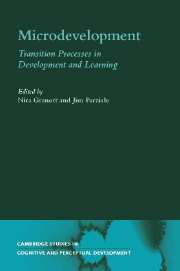Book contents
- Frontmatter
- Contents
- List of figures
- List of tables
- List of contributors
- Microdevelopment: A process-oriented perspective for studying development and learning
- Part I Variability
- Part II Transition mechanisms
- 4 A multi-component system that constructs knowledge: Insights from microgenetic study
- 5 Bridging to the unknown: A transition mechanism in learning and development
- 6 Observing the dynamics of construction: Children building bridges and new ideas
- Part III Micro- and macrodevelopment
- Part IV Context
- Author index
- Subject index
- References
6 - Observing the dynamics of construction: Children building bridges and new ideas
Published online by Cambridge University Press: 22 September 2009
- Frontmatter
- Contents
- List of figures
- List of tables
- List of contributors
- Microdevelopment: A process-oriented perspective for studying development and learning
- Part I Variability
- Part II Transition mechanisms
- 4 A multi-component system that constructs knowledge: Insights from microgenetic study
- 5 Bridging to the unknown: A transition mechanism in learning and development
- 6 Observing the dynamics of construction: Children building bridges and new ideas
- Part III Micro- and macrodevelopment
- Part IV Context
- Author index
- Subject index
- References
Summary
Perhaps the most useful element of the microdevelopmental approach is its demand for observations that are as direct and as continuous as possible. This use of evidence is in keeping with the successful practices of the natural sciences. Direct and continuous observations have provided the basis for most of the useful ideas of these sciences. What sort of notion would we have about cells if their structures and functions were not closely observed? Weren't centuries of careful observation required before the basic form and dynamics of the solar system were understood? For explanations to be valid in science they must be logical and arise from observations that are as close to the phenomena as possible. It is this emphasis on close observation that gives the microdevelopment approach its great explanatory potential.
Surprisingly, developmental psychology has made only limited use of this power of observation that the natural sciences depend on for so much. The microdevelopmental study described here attempted to reconnect developmental psychology to this potential by directly and continuously observing changes in fifth- and seventh-graders' conversations and actions as they worked in their everyday classroom. (The fifth-graders ranged from 10.8 to 12.1 years of age; the seventh-graders were between 12.7 and 13.7 years old.) During the task pairs of students built marshmallow-and-toothpick bridges across an eleven-inch (28 cm) gap between tables. Two lines of evidence, student conversations and actions, were then used to infer the children's lesson-related ideas and the mechanisms that built these ideas.
- Type
- Chapter
- Information
- MicrodevelopmentTransition Processes in Development and Learning, pp. 157 - 180Publisher: Cambridge University PressPrint publication year: 2002
References
- 4
- Cited by



